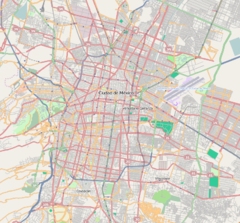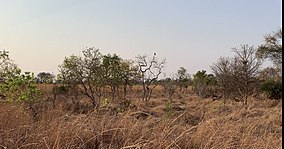페트로레오 역
Instituto del Petróleo metro station| STC 급행열차 | ||||||||||||||||
 2014년 5호선 플랫폼 | ||||||||||||||||
| 위치 | 에제 센트럴 구스타보 A. 멕시코시티 마데로 멕시코 | |||||||||||||||
| 좌표 | 19°29′22″N 99°08′43″W/19.489573°N 99.14526°W좌표: 19°29′22″N 99°08′43″W / 19.489573°N 99.14526°W | |||||||||||||||
| 운영자 | 시스테마 데 트랜스포테 콜렉티보(STC) | |||||||||||||||
| 회선 | ||||||||||||||||
| 플랫폼 | 4개의 측면 플랫폼(라인당 2개) | |||||||||||||||
| 트랙스 | 4개(행당 2개) | |||||||||||||||
| 연결 | ||||||||||||||||
| 건설 | ||||||||||||||||
| 구조형식 |
| |||||||||||||||
| 다른 정보 | ||||||||||||||||
| 상태 | 가동중 | |||||||||||||||
| 역사 | ||||||||||||||||
| 열린 | ||||||||||||||||
| 승객 | ||||||||||||||||
| 2020 | 합계: 1,809,035 | |||||||||||||||
| 순위 | ||||||||||||||||
| 서비스 | ||||||||||||||||
| ||||||||||||||||
| 위치 | ||||||||||||||||
 | ||||||||||||||||
| 영역지도 | ||||||||||||||||
페트롤레오 연구소(![]() Spanish 발음(Help·info; 스페인어 "페트로움 연구소")는 구스타보 A에 있는 멕시코시티 메트로 환승역이다. 멕시코 시티의 마데로.지하철 5호선(황색선)과 6호선(적색선)을 따라 각각 2개의 측면 승강장이 있는 지하역과 아타급역을 합친 역이다.페트로레오 연구소(Instituto del Petroleo)는 5호선의 폴리티코 역과 오토버스 델 노르트 역 사이에 위치하고 있으며, 6호선의 발레조와 린다비스타 역 사이에 위치하고 있다.발레델테페야크, 산 바르톨로 아테페후아칸, 누에바 공업의 콜로니아(근린)를 섬긴다.이 기지의 픽토그램은 석유 데릭을 묘사하고 있으며, 그 이름은 멕시코 석유 연구소 본부와 가깝기 때문에 붙여진 것이다.
Spanish 발음(Help·info; 스페인어 "페트로움 연구소")는 구스타보 A에 있는 멕시코시티 메트로 환승역이다. 멕시코 시티의 마데로.지하철 5호선(황색선)과 6호선(적색선)을 따라 각각 2개의 측면 승강장이 있는 지하역과 아타급역을 합친 역이다.페트로레오 연구소(Instituto del Petroleo)는 5호선의 폴리티코 역과 오토버스 델 노르트 역 사이에 위치하고 있으며, 6호선의 발레조와 린다비스타 역 사이에 위치하고 있다.발레델테페야크, 산 바르톨로 아테페후아칸, 누에바 공업의 콜로니아(근린)를 섬긴다.이 기지의 픽토그램은 석유 데릭을 묘사하고 있으며, 그 이름은 멕시코 석유 연구소 본부와 가깝기 때문에 붙여진 것이다.
페트로레오 역은 1982년 8월 30일 5호선이 폴리티크니코를 향해 북쪽으로 운행되면서 개통되었다.엘 로사리오행 6호선의 웨스트 서비스는 1983년 12월 21일에 시작되었다.역에는 멕시코 화가 에르네스토 폴센 캄바가 만든 석유 드럼으로 만든 페트로레오라는 제목의 조각품들이 소장되어 있다.2019년 이 역은 하루 평균 탑승객이 9,309명이었다.
위치
페트로레오 연구소(Instituto del Petroleo)는 구스타보 A에 있는 지하철 환승역이다. 멕시코시티 북부에 있는 마데로 자치구.역은 에제 센트럴(옛날 100메트로스 애비뉴 구간)을 따라 위치해 있으며, 발레델테페야크, 산 바르톨로 앗페후아칸, 누에바 공업의 콜로니아(멕시코어: "이웃"의 스페인어)를 서비스하고 있다.시스템 내에서, 그것은 5호선 폴리티크니코와 오토버스 델 노르트 역 사이에 있고, 6호선에서는 발레조와 린다비스타 역 사이에 있다.[2]이 지역은 페트롤레오(6호선)[3]라는 메트로부스 역이 운행하고 있으며, 트롤리버스 시스템의 1호선(이전의 A호선)이 운행하고 있으며,[4] 파사제로스 통신망의 23번과 103번 노선이 운행하고 있다.[5]
출구
6개의 출구가 있다:[2]
- 북동쪽:에제 센트럴 ("100 메트로스 애비뉴")과 마사과 거리, 발레 델 테페야크 (5호선)
- 노스웨스트: 100 메트로스 애비뉴와 마사과 거리, 발레 델 테페야크(5호선)
- 남동부: 100메트로스 애비뉴와 오타발로 거리, 산 바르톨로 아트페후아칸(6호선)
- 남서쪽: 100메트로스 애비뉴와 포니엔테 128번가, 산 바르톨로 아트페후아칸(6호선)
- 북쪽: 누에바 공업(6호선)의 포니엔테 134번가.
- 남부: 누에바 공업(6호선)의 포니엔테 134번가.
랜드마크
페트로레오 역 안에는 역을 위해 특별히 만들어진 7개의 조각상이 있다.연철기름 드럼통으로 만든 이 컬렉션은 페트로레오(1986)라는 이름으로 멕시코 조각가 에르네스토 폴센 캄바가 만들었다.[6][7]
역사와 건축

5호선 역은 엠프레사스 ICA의 자회사인 혜성로에 의해 지어져 1982년 8월 30일 폴리티코-판티틀란 서비스 첫날에 페트로레오 5호선이 개통되었다.[8][9][10]페트로레오-폴리테니코 국립통계연구소(Instituto del Petroleo-Politecnico interstation)의 길이는 1,188m(3,898ft)인 반면 페트로레오 국립통계연구소(Instituto del Petroleo-오토버스 델 노르트 섹션의 측정값은 1,067m(3,501ft)이다.[11]2006년 6월, 메트로 당국은 철도 스위치를 교체했고,[12] 2008년에는 기차역의 지붕에 정비를 했다.[13]
6호선 역은 혜성로에 의해 지하에[14] 지어졌다;[15] 발레조-페트로레오 역간 터널의 길이는 755m(2,477ft)이고 페트로레오-린다비스타 역간 터널은 1258m(4,147ft)이다.[16]1983년 12월 21일, 엘 로사리오-의 첫날, 페트로레오 6호선이 개통되었다.페트로레오 연구소 서비스.1986년 7월 8일, 마르틴 카레라행 서비스가 시작되었다.[17]
두 라인을 연결하는 승객 이동 터널의 길이는 약 500m(1,640ft)이다.[18]이 기지의 픽토그램은 석유 데릭을 묘사하고 있으며, 그 이름은 본사가 있는 멕시코 석유 연구소를 가리키고 있으며,[2] 시설 내에 인터넷 카페가 있다.[2]
사건
2018년 7월 19일, 역 승강장에서 16세 남성이 40세 남성에게 가위로 찔렸다.그 부상은 입원을 보증하지 않았고 공격자는 검찰청에 회부되었다.[19]2020년 11월 8일 페트롤레오 연구소, 폴리트레크니코, 린다비스타 역은 페트롤레오, 폴리트레치코, 린다비스타 역이 페미니스트 시위 도중 파손되어 벽화, 난간, 기차, 벽화 등이 파손되고 그라피티되었다.[20]
라이더십
2000년대 이후 당국이 제공한 자료에 따르면, 연구소 델 페트로레오 역은 이 시스템의 195개 역 중 가장 덜 붐비는 역 중 하나였다.통근자들은 2020년을 제외하고 5호선 일일 출입구 4,700~7,500개, 6호선 일일 출입구 2,900~4,800개 사이로 연평균 진입했다.2019년 이 역은 총 339만8142명의 승객을 태웠다.5호선 이용객은 221만5325명(하루 6,069명)으로 2018년에 비해 4만310명이 증가했다.6호선 이용객은 118만2817명(하루 3240명)으로 2018년에 비해 4만176명이 줄었다.[21][22]
2019년 5호선 역은 시스템 중 180번째로 가장 붐비는 역이었고 10번째로 붐비는 역이었다.6호선 역은 시스템에서 193번째로 혼잡했으며, 노선의 두 번째 차선이었다.[21]
| 연간 여객승객선(5호선) | |||||
|---|---|---|---|---|---|
| 연도 | 라이더십 | 일평균 | 순위 | % 변화 | 참조 |
| 2020 | 1,243,272 | 3,396 | 179/195 | −43.88% | [21] |
| 2019 | 2,215,325 | 6,069 | 180/195 | +1.85% | [21] |
| 2018 | 2,175,015 | 5,958 | 181/195 | +7.94% | [22] |
| 2017 | 2,014,941 | 5,520 | 184/195 | +1.17% | [23] |
| 2016 | 1,991,703 | 5,441 | 184/195 | −3.48% | [24] |
| 2015 | 2,063,423 | 5,653 | 173/195 | −0.14% | [25] |
| 2014 | 2,066,254 | 5,660 | 175/195 | −4.62% | [26] |
| 2013 | 2,166,402 | 5,935 | 184/195 | −3.93% | [27] |
| 2012 | 2,255,046 | 6,161 | 166/195 | −16.79% | [28] |
| 2011 | 2,710,174 | 7,425 | 157/175 | +39.62% | [29] |
| 2010 | 1,941,042 | 5,317 | 162/175 | +2,531.71% | [30] |
| 2009 | 1,973,664 | 5,407 | 160/175 | −5.04% | [31] |
| 2008 | 2,078,441 | 5,678 | 159/175 | +20.12% | [32] |
| 2007 | 1,730,319 | 4,740 | 160/175 | −38.50% | [33] |
| 2006 | 1,892,075 | 5,183 | 159/175 | – | [34] |
| 연간여객승마권(6호선) | |||||
|---|---|---|---|---|---|
| 연도 | 라이더십 | 일평균 | 순위 | % 변화 | 참조 |
| 2020 | 565,763 | 1,545 | 193/195 | −52.17% | [1] |
| 2019 | 1,182,817 | 3,240 | 193/195 | −3.29% | [21] |
| 2018 | 1,222,993 | 3,350 | 192/195 | −5.44% | [22] |
| 2017 | 1,293,320 | 3,543 | 192/195 | −3.60% | [23] |
| 2016 | 1,341,565 | 3,665 | 192/195 | −8.33% | [24] |
| 2015 | 1,463,420 | 4,009 | 182/195 | +11.31% | [25] |
| 2014 | 1,314,717 | 3,601 | 184/195 | −6.51% | [26] |
| 2013 | 1,406,332 | 3,852 | 191/195 | −18.40% | [27] |
| 2012 | 1,723,365 | 4,708 | 173/195 | +5.95% | [28] |
| 2011 | 1,626,530 | 4,456 | 172/175 | +34.52% | [29] |
| 2010 | 1,209,170 | 3,312 | 172/175 | −1.87% | [30] |
| 2009 | 1,232,240 | 3,376 | 173/175 | −1.30% | [31] |
| 2008 | 1,248,477 | 3,411 | 172/175 | −2.92% | [32] |
| 2007 | 1,285,973 | 3,523 | 171/175 | −56.12% | [33] |
| 2006 | 1,064,784 | 2,917 | 173/175 | – | [34] |
참조
- ^ a b c d e "Afluencia de estación por línea 2020" [Station traffic per line 2020] (in Spanish). Sistema Transporte Colectivo Metro. 2021. Archived from the original on 21 June 2021. Retrieved 21 June 2021.
- ^ a b c d "Instituto del Petróleo" (in Spanish). Sistema Transporte Colectivo Metro. Archived from the original on 17 February 2020. Retrieved 21 November 2020.
- ^ "Mapa completo del sistema" [Complete system map] (in Spanish). Mexico City Metrobús. Archived from the original on 11 January 2020. Retrieved 23 November 2020.
- ^ "Línea 1" [Line 1] (in Spanish). Servicio de Transportes Eléctricos. Archived from the original on 29 February 2020. Retrieved 24 December 2020.
- ^ "Red de Rutas" [Routes network] (in Spanish). Red de Transporte de Pasajeros. Retrieved 30 October 2021.
- ^ Ventura, Abida (21 December 2020). "El Metro: el gran museo "underground" del DF" [Metro: Mexico City's large "underground" museum]. El Universal (in Spanish). Archived from the original on 28 July 2018. Retrieved 22 December 2020.
- ^ Espino Arévalo, Fernando (12 November 2013). "Proposición con punto de acuerdo por el que se exhorta a la Comisión de Presupuesto y Cuenta Pública de la Asamblea Legislativa del Distrito Federal, para que en el Presupuesto de Egresos del Distrito, Federal correspondiente al ejercicio fiscal 2014, se asignen recursos al Sistema de Transporte Colectivo Metro para llevar a cabo la preservación, conservación y restauración de los bienes culturales ubicados en sus instalaciones" [Proposal with a consensus that urges the Budget and Public Account Commission of the Federal District Legislative Assembly to allocate resources in the Federal District Expenditure Budget for fiscal year 2014 to the Sistema de Transporte Colectivo Metro to carry out the preservation, conservation and restoration of the cultural assets located in its facilities] (PDF) (in Spanish). Legislative Assembly of the Federal District. p. 4. Archived (PDF) from the original on 27 November 2020. Retrieved 22 December 2020.
- ^ "Línea 5, Ciudad de México" (in Spanish). iNGENET Infraestructura. 20 July 2009. Archived from the original on 2 September 2014. Retrieved 15 April 2020.
- ^ Pérez Cisneros, Tonatiuh (7 May 2018). ""El 8", el aterrador sitio del Metro Instituto del Petróleo" ["The 8", the scary location at Instituto del Petróleo metro station] (in Spanish). Reversos.mx. Archived from the original on 25 August 2020. Retrieved 23 August 2020.
- ^ Chávez García, Luis Alberto (1 June 2016). "Dip. Ana Juana Ángeles Valencia" [Deupty Ana Juana Ángeles Valencia] (PDF) (in Spanish). Legislative Assembly of Mexico City. p. 2. Archived (PDF) from the original on 25 August 2020. Retrieved 23 August 2020.
- ^ "Longitud de estación a estación por línea" [Station-to-station length per line] (in Spanish). Sistema de Transporte Colectivo Metro. Archived from the original on 4 May 2021. Retrieved 12 July 2021.
- ^ "Cerrarán el viernes tres estaciones de la línea 5 del Metro" [Three Line 5 stations will be closed next Friday]. La Jornada (in Spanish). 13 June 2006. Archived from the original on 25 August 2020. Retrieved 23 August 2020.
- ^ "Marzo 28 08" [March 28 08]. Mexico City Official Journal (in Spanish). 28 March 2008. p. 1. Archived from the original (PDF) on 25 August 2020. Retrieved 23 August 2020.
- ^ "Instituto del Petróleo Metro Station (Línea 6) (Mexico City, 1983)". Structurae.net. Archived from the original on 23 December 2020. Retrieved 21 November 2020.
- ^ "Línea 6, Ciudad de México" (in Spanish). iNGENET Infraestructura. 20 July 2009. Archived from the original on 20 June 2020. Retrieved 22 December 2020.
- ^ Gamez Rojas, Marlen (2010). "Análisis de riesgos de incendio en el Sistema de Transporte Colectivo Metro" [Analysis of fire risks in the Sistema de Transporte Colectivo Metro] (PDF) (in Spanish). Escuela Superior de Ingeniería Mecánica y Eléctrica. Instituto Politécnico Nacional. pp. 94–95. Archived from the original (PDF) on 23 November 2020.
- ^ "¿Quieres festejar al Metro? ¿Qué tal un vagón lleno? Estas son las estaciones más concurridas" [Do you want to celebrate the Metro? What about a full car? These are the busiest stations] (in Spanish). El Financiero. Archived from the original on 23 December 2020. Retrieved 22 December 2020.
- ^ "Transbordos en el Metro ¿una opción para ejercitarte?" [Metro transfer, a workout option?]. Milenio (in Spanish). 12 January 2018. Archived from the original on 17 January 2019. Retrieved 28 May 2020.
- ^ "Apuñalan a menor de edad en estación del Metro Instituto del Petróleo" [Minor stabbed in Instituto del Petróleo metro station] (in Spanish). El Big Data. 19 July 2018. Archived from the original on 23 December 2020. Retrieved 22 December 2020.
- ^ López, Jonás (8 November 2020). "Encapuchadas hacen destrozos en estaciones de L5 del Metro" [Masked female protesters shatter L5 metro stations]. Excélsior (in Spanish). Mexico City. Archived from the original on 9 November 2020. Retrieved 8 November 2020.
- ^ a b c d e "Afluencia de estación por línea 2019" (in Spanish). Sistema Transporte Colectivo Metro. 2020. Archived from the original on 3 July 2020. Retrieved 3 May 2020.
- ^ a b c "Afluencia de estación por línea 2018" (in Spanish). Sistema Transporte Colectivo Metro. 2019. Archived from the original on 6 June 2019. Retrieved 7 April 2020.
- ^ a b "Afluencia de estación por línea 2017" (in Spanish). Sistema Transporte Colectivo Metro. 2019. Archived from the original on 3 May 2020. Retrieved 3 May 2020.
- ^ a b "Afluencia de estación por línea 2016" (in Spanish). Sistema Transporte Colectivo Metro. 2017. Archived from the original on 3 May 2020. Retrieved 3 May 2020.
- ^ a b "Afluencia de estación por línea 2015" (in Spanish). Sistema Transporte Colectivo Metro. 2016. Archived from the original on 3 May 2020. Retrieved 6 May 2020.
- ^ a b "Afluencia de estación por línea 2014" (in Spanish). Sistema Transporte Colectivo Metro. 2015. Archived from the original on 3 May 2020. Retrieved 6 May 2020.
- ^ a b "Afluencia de estación por línea 2013" (in Spanish). Sistema Transporte Colectivo Metro. 2014. Archived from the original on 3 May 2020. Retrieved 6 May 2020.
- ^ a b "Afluencia de estación por línea 2012" (in Spanish). Sistema Transporte Colectivo Metro. 2013. Archived from the original on 3 May 2020. Retrieved 6 May 2020.
- ^ a b "Afluencia de estación por línea 2011" (in Spanish). Sistema Transporte Colectivo Metro. 2012. Archived from the original on 6 May 2020. Retrieved 6 May 2020.
- ^ a b "Afluencia de estación por línea 2010" [Station traffic per line 2010] (in Spanish). Sistema Transporte Colectivo Metro. 2011. Archived from the original on 7 May 2020. Retrieved 6 May 2020.
- ^ a b "Afluencia de estación por línea 2009" [Station traffic per line 2009] (in Spanish). Sistema Transporte Colectivo Metro. 2010. Archived from the original on 24 September 2011. Retrieved 19 August 2021.
- ^ a b "Afluencia de estación por línea 2008" [Station traffic per line 2008] (in Spanish). Sistema Transporte Colectivo Metro. 2009. Archived from the original on 27 September 2011. Retrieved 19 August 2021.
- ^ a b "Afluencia de estación por línea 2007" [Station traffic per line 2007] (in Spanish). Sistema Transporte Colectivo Metro. 2008. Archived from the original on 27 September 2011. Retrieved 19 August 2021.
- ^ a b "Afluencia de estación por línea 2006" [Station traffic per line 2006] (in Spanish). Sistema Transporte Colectivo Metro. 2008. Archived from the original on 27 September 2011. Retrieved 19 August 2021.
외부 링크
 위키미디어 커먼스의 연구소(역) 델 페트로
위키미디어 커먼스의 연구소(역) 델 페트로- "Metro Instituto del Petróleo". At the Official Guide to Mexico City.




